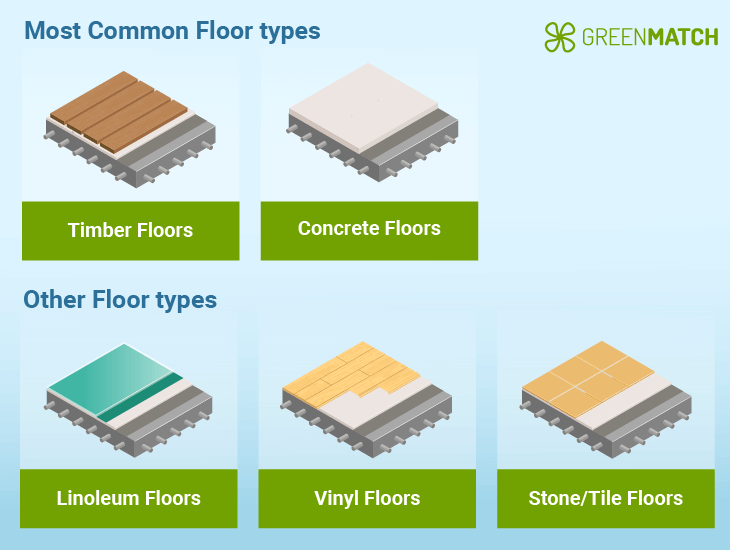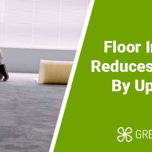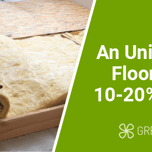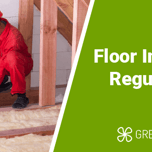Answer these simple questions and we will find you the BEST prices
Which type of solar quotes do you need?
It only takes 30 seconds
100% free with no obligation

Get Free quotes from insulation specialists near you

Save money by comparing quotes and choosing the most competitive offer

The service is 100% free and with no obligation
- GreenMatch
- Insulation
- Floor Insulation
Floor Insulation in the UK: What Is It & How Does It Work?


- Floor insulation helps reduce heat transfer through the materials of the floor, helping reduce heating and energy expenses.
- Insulation is applied under or above the floor through thermally efficient materials that seal up areas where heat can escape.
- An adequately insulated floor can reduce annual energy costs by £60 to £85 for the average home in the UK.
Floor insulation can be a crucial step in reducing energy expenses and the carbon footprint of the average home. The type of insulation you require can vary based on the type of floor you have, which could mean installing either internal or external insulation. Let’s go over the various types of insulation and whether they’re right for you.
But first, if you’re looking into installing insulation for the floor of your house, it’s best to check with a reliable professional. Finding one can take days of research and comparing prices which the average person does not have time for. So, why not try out our free service?
All you need to do is fill out a quick 30-second form and we’ll provide you with up to 3 free quotes with no obligation on your part. Click the button below to get started.
- Describe your needs
- Get free quotes
- Choose the best offer
It only takes 30 seconds



What is floor insulation?
Floor insulation requires placing a material above or under a floor to reduce heat loss and improve energy efficiency. The effectiveness and cost of insulation can vary depending on the material used, what type of floor is being replaced, the complexity of the installation, and the energy efficiency of the home.
The most common insulation measures deal with suspended timber or concrete floors, requiring foams, fibres, wool, or rubber. These can be placed underneath the floor if suspended timber, or above if concrete during a retrofit, but the ease of application varies based on the floor material.
Insulating floors can improve energy efficiency by 10% to 20% in homes with low EPC ratings. Insulation also helps make homes more comfortable and decreases their carbon emissions by 120kg to 190kg per year, allowing for more sustainable living.
Floor insulation costs around £4,700 on average but this can depend on the size of the floor, the materials used, and what type of floor it is.
How to insulate a floor
The process of installing insulation for floors can vary based on the type of floor and type of insulation, but the most common steps include:
- Assessing your floor type: You need to know what materials you’re dealing with. They might be suspended timber or concrete, most commonly. Often, when you insulate floors in an old house, you tend to encounter suspended timber flooring, while newer homes tend to have concrete.
- For wooden floor insulation: Underfloor insulation for wooden floors consists of raising the flooring and installing materials like mineral wool or placing foam insulation between floor joists.
- For concrete floor insulation: While solid floors are less of a heat loss hazard than suspended timber floors, you may still want to insulate them. This can be done by adding EPS or rigid foam insulation on top. Underfloor insulation is easier to add during construction or floor repairs.
- Excluding draughts: The usual culprits include doors, radiator pipes, floorboards and chimneys which can all diminish energy efficiency. You may also want to insulate the floor of your loft or attic if you have one. Placing carpets or utilising sealants can be a good way to solve many of these problems.
- Covering or sealing the floor gaps: If you’ve got wooden floors you can keep heat in by laying down rugs and carpets and also sealing gaps between boards. Installing insulation for floors does not necessarily require a professional but this can depend on the job. DIY floor insulation is easier with replaceable floorboards, applying foam to gaps, and putting batts or wool under homes that have crawl spaces.
Types of floor insulation
Different types of floor insulation alter the noise reduction, level of heat insulation, and how the floor deals with moisture. The most popular types include:

- Rigid insulation sheets: Made from several types of materials, including expanded polystyrene (EPS), polyisocyanurate (PIR) and others, these sheets are easy to install, very robust, and pressure-resistant. It carries a high insulation value and is relatively sustainable.
- Polyurethane spray: Use as an excellent air-sealing foam with great insulation properties. PU sprays are particularly good for covering up gaps and irregularities in the floor. Best for wooden floorboards or floor cavity insulation. Despite its many advantages, it is comparatively less sustainable, which is why polystyrene can be a good alternative to it.
- Mineral wool: Rock or mineral wool has a lot of great properties such as thermal efficiency, sound insulation, and fire resistance. It can be installed beneath floor joists or used as insulation under carpets.
- Rubber: Rubber insulation can be a great option for certain types of floors, such as vinyl or linoleum, which are not compatible with EPS or PU. It can be less intrusive for these materials as the flooring might become uneven with the others.
- Insulating screed: Screed is a mixture of cement and insulation material such as polystyrene granules. Its performance is often improved with the use of other materials such as polystyrene.
- Fibreglass batts: Fibreglass batts are solid chunks of processed glass and can be a good underfloor insulation solution material but could be prone to moisture issues. Great for installing under floorboards or covering up crawl spaces.
- Carpeting: Various types of carpeting allow for better insulation on retrofits and can be easily applied. The thermal properties of carpets can also be enhanced with another form of insulation when inserted between the floor and the carpet material.
Mineral wool, rubber, screed, and fibreglass are the best options in terms of sustainability, while plastics like polystyrene and polyurethane insulation are less so.
Types of floors

The most common type of flooring in the UK is either concrete or suspended timber. These two can have very different insulation needs, with the latter allowing for insulation underneath floorboards and the former requiring materials placed above it.
- Suspended timber floors: Wooden floors can be easily insulated if they have floorboards or crawl space underneath. Proper moisture control and ventilation can be especially necessary with wood. Mineral wool and rigid PU or EPS foams can be fitted underneath floor joists.
- Concrete floors: Concrete can be hard to remove, so insulation is largely done for newly built homes or renovations. EPS and other foams are especially suitable underneath. Most ground floor insulation in the UK deals with concrete.
Other types of flooring also include:
- Vinyl flooring: Vinyl floor insulation can be tricky since specific types of vinyl might work best with different forms of insulation. Underlying rubber is a popular choice but many forms of insulation can make vinyl floors uneven if not chosen carefully.
- Linoleum flooring: Linoleum is a type of flooring made from a range of natural materials including linseed oil, cork dust, wood flour, pine resin, ground limestone, and pigments. Linoleum flooring works best with foams and plastic insulations.
- Stone or tile flooring: For stone and tile flooring, you may need to lay down a damp-proof membrane before you add EPS or other forms of insulation.
Pros and cons of floor insulation

Pros:
- Decreases energy consumption: The average home in the UK can save about £60 to £85, going up to £110 for larger homes. About 10% to 20% of a building’s heat is potentially lost through the floor if it has inadequate insulation.
- Decreases carbon footprint: Installing insulation under floor panels and boards can lead to a decrease in carbon emission up to 120 to 190 kilograms of CO2 for an average-sized home in the UK.
- Grants can subsidise insulation costs: Grants like the Great British Insulation Scheme and ECO4 can help pay qualifying homes for partial or even full underfloor insulation depending on the size of the job. The applicability of these grants can depend on your income status and your home’s energy efficiency.
- Improves sound-proofing: The extra layer also can block out noise, allowing for a bit of peace and quiet in your home. This can be handy in an apartment complex where sound insulation for floors can be required.
- Zero post-installation maintenance: Once installed, floor insulation requires no further work or maintenance.
- Warmer floors in winter: Aside from blocking out heat from escaping, insulation and carpeting can make floors warmer if the materials that comprise them get cold too easily.
Cons:
- Not the most cost-effective insulation: If your main concern is immediately decreasing heating and energy costs, flooring insulation may not be a priority. Other forms of insulation such as cavity wall insulation have a better return on investment.
- Potentially expensive for some homes: If your home can not be carpeted and the floors are hard to remove, your home may require a different form of insulation.
- Multi-floor houses can be costly: While ground installations are fairly simple, insulation for the floor above can be an issue. It will require more extensive work.
Is floor insulation the right choice for my home?
An insulated floor can bring in energy savings and help reduce your carbon footprint, allowing for yearly savings that can range from £60 to £85 for the average-sized home. For larger homes, it can be worth it, often saving up to £110 annually. Matching the right insulation material with the right floor material is crucial.
Floors are an essential part of the home’s heating insulation and could be losing you a lot of money on your energy bills. It can also raise your house’s property value. It is also simple to apply for most homes.
If you’re still not sure about floor insulation or what type of insulation you need, it might be best to contact an installer. A reliable one can get you the best floor insulation, keep your costs down, and even aid in navigating insulation grants. However, finding one can take days of strenuous research and calling up companies. To avoid all that hassle, you can instead use our quick and easy service.
We’ve got a network of thoroughly vetted companies who can provide you with the best prices. Click the button below, fill out a 30-second form, and we’ll get back to you with up to 3 free, non-binding quotes from reputable installers in your area.
- Describe your needs
- Get free quotes
- Choose the best offer
It only takes 30 seconds



FAQ
Floor insulation must meet minimum energy efficiency values or the best standard achievable on that particular property within a payback of 15 years or under. It’s best to consult an installer to see what regulations apply in your area.
Floor insulation can lead to savings of between £60 to £85 and allow for noise reduction. The level of efficiency may depend on the type of material used.
Achieving a u-value of 0.25 is a good target for any insulation measure. However, thicker materials can make the foundation uneven for certain floor materials.
Floor insulation can be applied under the floor or above, depending on the type of floor you have. Sealing gaps, installing thermally efficient materials, installing carpets, and many other methods allow for better insulation.

Rawal Ahmed is a writer at GreenMatch with an interest in sustainability and a background in tech journalism and digital marketing.
We strive to connect our customers with the right product and supplier. Would you like to be part of GreenMatch?




